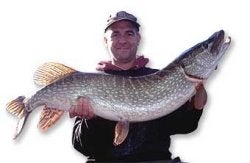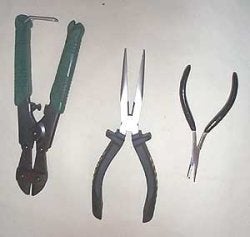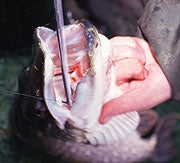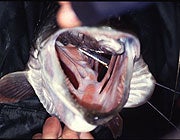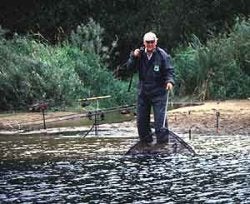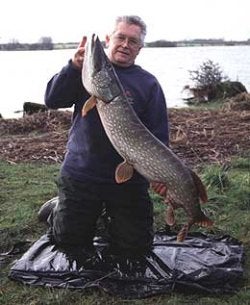If there is a more striking fish swimming in British waters than the pike I have yet to see it, and yet throughout the years she has had few friends. A much maligned fish, the pike has been regarded as the age-old enemy of the fisherman, a creature who will devour anything that passes her way: fish, ducks, dogs and even small children have been gobbled up by this malevolent predator. What absolute rubbish!
Victimised By Neanderthals It was once common to see this unfortunate fish victimised in a systematic attempt to rid a water of its presence. Years ago most club anglers would fish for their favourite roach or bream with a ‘bung rod’ set up alongside. The idea being that this rod would be left to look after itself whilst the angler concentrated his attention on the ‘real’ job. This would only be interrupted if the bung chugged through his swim or the boat rod started to scrape along the bank as a gut-hooked fish swam away with the dead roach. The unfortunate fish would then be thrown up the bank or taken home to show the kids before being consigned to the dustbin. The ironic thing about this is that these Neanderthals didn’t realise that these actions were in fact contributing to the fishery’s downfall by ensuring that the water became a prolific jack pike fishery. Like all things in nature the pike is self regulating, the constant removal of large, highly cannibalistic pike from a water only ensures that even smaller, aggressive jacks make it through the first few years of life. This in turns means a dramatic upturn in the number of predators in the lake, which in turn ensures that the silver fish, which the pike slaughterer’s were desperate to protect, are soon devoured by the hoards of tiny pike. Well done lads – another plan gone tits up!
The Essential Kit In fact the pike, for all his awesome appearance is a very delicate fish, a fish that thrives on neglect and needs the most careful handling possible if it is to remain in good health. It is for this reason that in this series of articles I will initially concentrate on pike welfare before exploring the many ways in which it can be caught. There are several ‘must have’s’ before starting pike fishing and no-one should even attempt to fish for pike without the following pieces of equipment. | ||||||||||
You will notice I haven’t mentioned rods, reels, lines, etc. This is because the hooking and landing of pike is a relatively straightforward process; the real skill comes in making sure she goes back in the best possible condition. Let’s concentrate on fish welfare first and move onto catching our quarry later. Step By Step Unhooking Guide
OK, let’s assume the pike is in the landing net ready for unhooking. The easiest way to progress is to cut your line above your trace and place your rod back in the rest, with the pike still in the water supported by the folds of the landing net. Your unhooking mat should already be positioned on a level surface, preferably surrounded by grass or dead leaves in case we have a mishap or a particularly lively specimen on our hands. Place the pike onto the mat whilst still in the net. Now, squat down with the pike positioned between your legs, gently holding it in position with your knees. (If you don’t want to get your legs wet then don’t go pike fishing!). Turn her onto her back, and slip your hand inside the gill cover with your thumb against the outside of its gill plate and, being careful to avoid the delicate but abrasive gill rakers, move your hand towards the apex of her jaw. Once it comes to rest take a firm grip and pull the pike’s head up towards you. Her mouth will automatically open and, assuming you have struck instantly, the hooks will be visible and easily removed. Buy the forceps which have short jaws, you can get much more leverage on the hooks using these than you can with some of the long-nosed ones which are available. This will make the whole process much easier. Forceps
Should the hooks be a little deeper than you hoped, then use the medium sized forceps to reach the hooks by gently working the points through the gill covers, again being very careful to avoid the rakers. If damaged these will bleed profusely and can easily kill the fish through loss of blood. If you are nervous of doing this with a bare hand then a gardening glove, wetted prior to use, will protect you against the rakers and should give you a bit more confidence when holding the jaw. Don’t Panic! A common mistake which I see with unfortunate regularity is to panic and let go of the fish if it attempts to thrash about. This will damage both you and the pike. The gill rakers and any inner teeth that you may come into contact with can rip flesh if you let go at this stage, whereas keeping a firm grip on its jaw and tightening your knees onto its body will result in the pike settling down after just a few seconds. Remember you are much stronger than the pike and if you hold firm it will soon settle. Once a few fish have been unhooked in this way you will be amazed at how easy this process is and you will also be able to ‘read’ when the pike is about to wake up as you can feel its whole body tense just before it starts to attempt to twist from your grasp. In an ideal world you should fish for the first time with an experienced pike fisherman who will make the whole operation seem terribly easy.
If the pike is hooked in the soft flesh in the throat there is still no need to panic. Just pull gently on the trace until the shank of the hook is visible, then again going in through the gills grasp the shank firmly with the forceps and invert the hook by turning it through 180 degrees. Assuming you are using barbless or semi barbless hooks the hook will just pop out. It is for this reason that I NEVER used barbed hooks when bait fishing. The real risk of stitching up a pike’s throat with barbed trebles is just too great and I can see no excuse for using fully barbed hooks in this day and age. Think about it, do you want the death of the fish of a lifetime on your conscience? Bolt Croppers I also carry a pair of mini bolt croppers, these are readily available (I got mine from B&Q) and they will cut through a hook with ease. I find them particularly useful when the pike has twisted in the landing net, ensnaring the hooks in the process. A couple of snips and the hooks are free, allowing easy and effective unhooking to take place. I also use them when a hook has taken an extremely stubborn hook hold, usually in the scissors where the treble hook sometimes refuses to come free easily. Again a couple of snips and the hook falls out – remember replacement treble hooks come cheaply, a big pike does not!
Unhooking Mat Get the largest unhooking mat you can find, I use the largest Nash Euro mat which has a thick, padded base, a zip fastener and a strong handle which allows me to unhook, weigh and return the fish without ever removing it from the safety of the mat. I like to take the fish back into the water before unzipping the mat, this way there is no possibility of the fish sliding out and injuring itself. If you have an unhooking mat that doesn’t zip up then please return the fish by placing it back in the weigh sling or landing net before returning to the water ready for releasing. I have seen pike dropped in the short distance from the hooking mat and if this should happen the pike will invariably die. It takes just an extra couple of seconds to do this but it is time well spent. Once you have the fish back in the water don’t be in a rush to let it go. Hold it firmly by the tail root whilst supporting its belly with your other hand. Keep it in this position for as long as it takes until it starts to pull against you, once you release your grip on its tail it should swim off strongly, none the worse for the experience. |
Welcome!Log into your account










